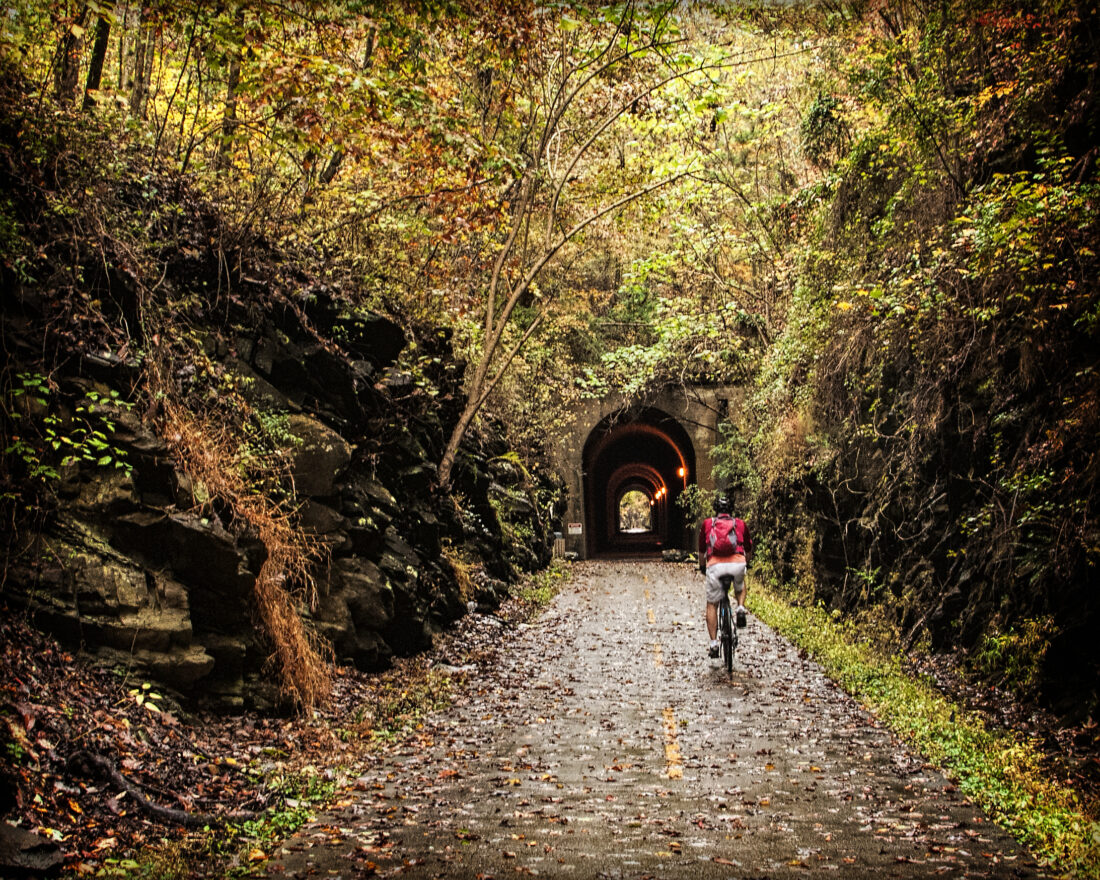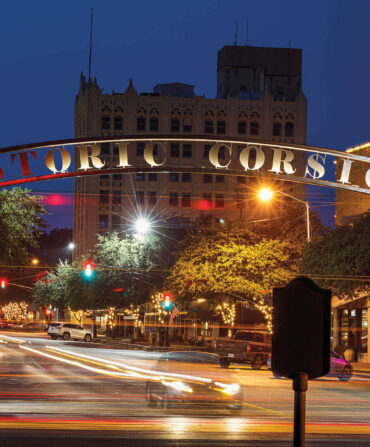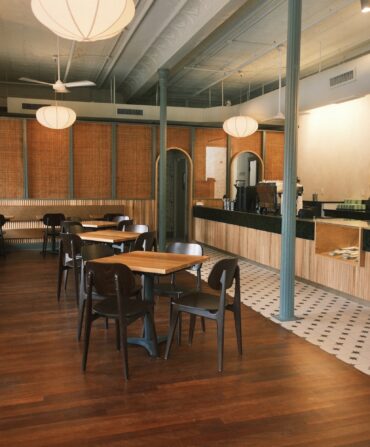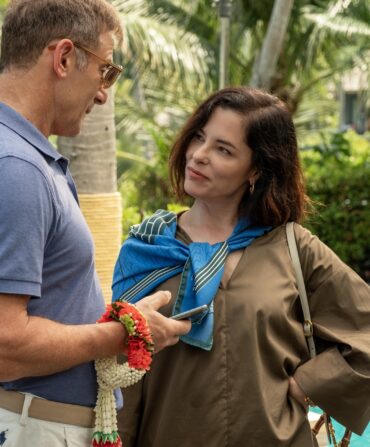Morning came early for the cyclists gathering at Cedartown Depot, a landmark along Georgia’s Silver Comet Trail that doubles as a welcome center and overlooks both the rail trail and the active CSX rail line. Across the tracks, the brightly painted words “Welcome Traveler” on the side of a warehouse caught my eye, refurbished bikes hung around the letters. The two words embodied the spirit of our group’s fifty-mile journey ahead, one beginning here in this sleepy West Georgia town on the Silver Comet and soon crossing onto Alabama’s Chief Ladiga Trail.
Every rail trail tells a story. Behind each ordinance passed, acre of brush cleared, and ribbon cut lies a vision backed by a community. Together, these two iconic rail trails, the Silver Comet and the Chief Ladiga, inspire cyclists from all circles to pedal their cumulative 105 miles, which trace a historic rail line from Smyrna, Georgia, to Anniston, Alabama, where a new six-mile extension just opened. Autumn, in particular, is prime time for pedaling pilgrims, with mild temperatures and dense forests burning with fall colors beckoning along with occasional whistle-stops dotted with trailside restaurants, charming shops, and historic sites worth a detour.
This group ride, organized by Rails to Trails Conservancy, the nation’s largest trails organization and quarterback of the rail-trail movement, began near the adjoining trails’ midpoint in Cedartown. With a population of a little more than ten thousand, the burg illuminates just how deeply a trail can shape the fabric of a place. Jane Wyatt, a longtime local and former Polk County Chamber president, emphasized that point. “Momentum around the 1996 Atlanta Olympics helped kick-start funding for the Silver Comet, and trail construction began soon after in 1998,” she explained. “Since then, we’ve enjoyed welcoming visitors to Cedartown from all over.”
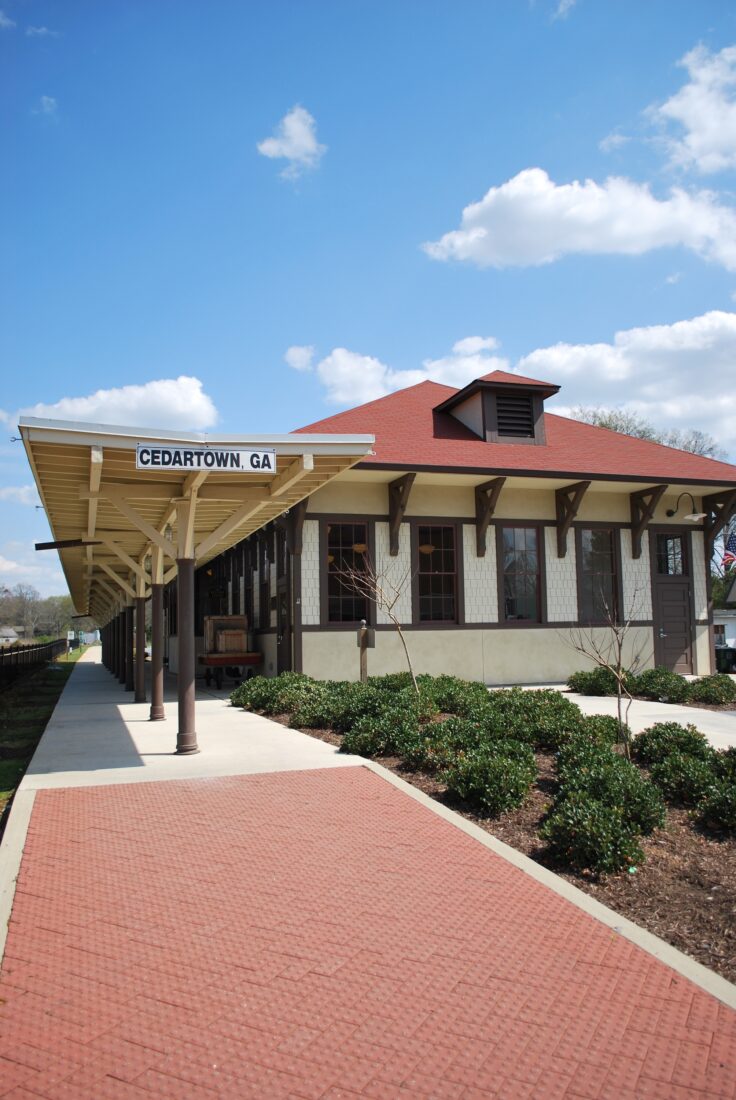
Many of those visitors (particularly the golf lovers) flock to the Doug Sanders Golf Museum, which commemorates the Cedartown native turned PGA star. The evening before, Wyatt had taken us on a walking tour of the quaint downtown that included the timeless West Cinema and a brief stop at the Polk County Historical Society Museum, where we sifted through local artifacts and discovered yet another hometown hero: the celebrated midcentury voice actor Sterling Holloway, who voiced Disney’s Winnie the Pooh, among other characters.
But now it was time to put pedal to pavement. As we left Cedartown behind that morning, we rolled past picturesque farmland and through rain-soaked greenery. Our first stop, State Line Gateway Park, arrives quickly. There, a bright red arch stretches over the path, welcoming riders to Alabama. Though only ten miles into our trek, I felt the familiar rush of accomplishment that comes with crossing any state line, whether by car, bike, or foot. After a group photo and brief water stop, we embarked on the Chief Ladiga, which winds nearly forty miles through Talladega National Forest and past six municipalities.

As we rode west, the trail slipped deep into the forest. Towering pines lined the path as Terrapin Creek bended alongside, offering riders sweeping views from atop the trail’s wooden bridges. Cows soaked in glass-like ponds, roosters crowed, and hounds fiercely guarded private property lines. Craggy rocks flanked the pathway, dripping beads of water onto the trail’s damp asphalt. In the distance, Dugger Mountain rose against the Northeast Alabama skyline.
After twenty-five miles in the saddle, even a five-dollar hot-and-ready from Little Caesar’s would’ve tasted like fine dining. Fortunately, Piedmont serves up something much tastier at Pinhoti Pizza Company, which became the town’s first trailside restaurant when it opened last fall. Inside, trail maps and bikes adorn the walls, a nod to the outdoor spirit of co-owners Maggie and Kevin Cunningham. Outside, an expansive patio sits adjacent to the trail, enticing pedestrians, cyclists, you name it, to make a carb-loaded detour.
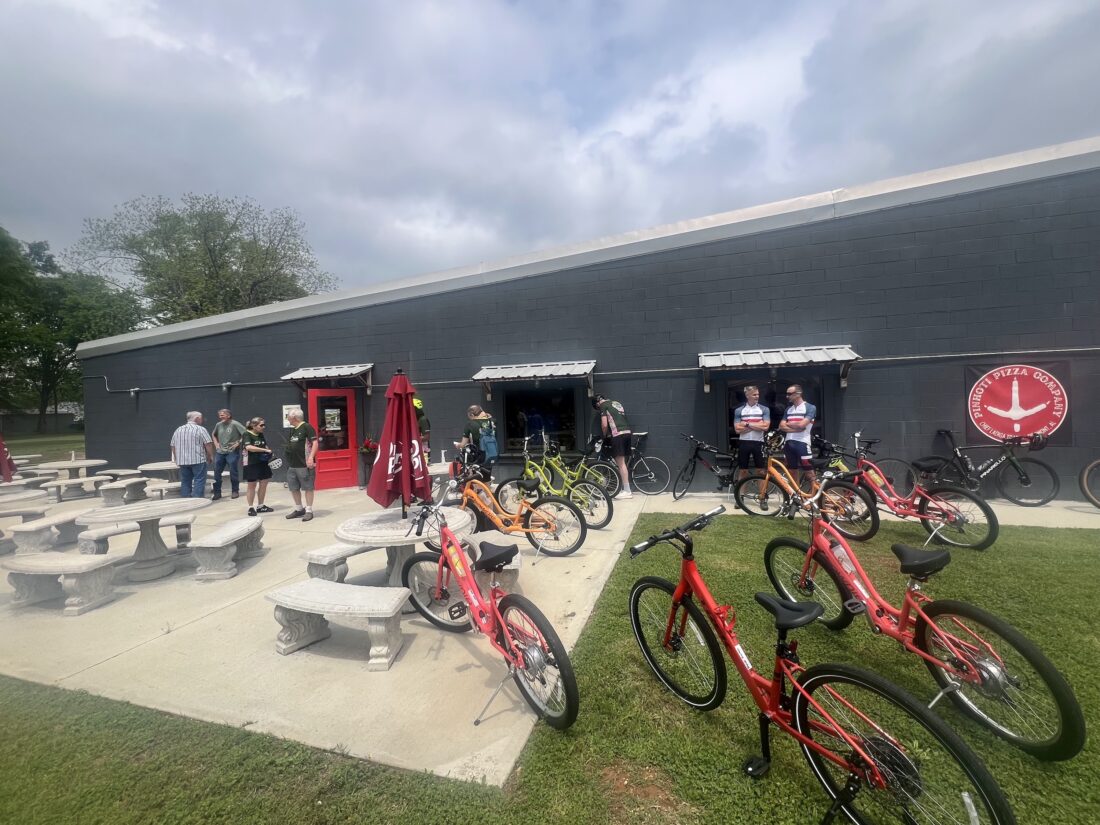
While the restaurant overlooks the Chief Ladiga, it’s named after another major multistate pathway in Piedmont’s backyard: the Pinhoti Trail, a 335-mile backpacking route between Georgia and Alabama that links hikers directly to the Appalachian Trail. Just past the state line, the Pinhoti crosses the Chief Ladiga, a collision of outdoor subcultures where spandex-clad cyclists meet pack-loaded hikers.
Together, the Chief Ladiga, the Pinhoti, and Terrapin Creek give Piedmont all the right ingredients to become one of the South’s next up-and-coming outdoor towns. “This trail has been a lifeline for our community,” Maggie told me. “Anything you want to do outside, you can do here. We call Piedmont the outdoor trifecta: Hike the Pinhoti, bike the Chief Ladiga, and float Terrapin Creek. Since we opened last fall, people have seen bikes parked outside and are starting to realize what this area can become.”
During our visit, Maggie proved herself a woman of many hats. After warmly greeting riders, she hopped on stage to join the two-man guitar band, channeling her John Prine meets Bonnie Raitt vocals for a soulful cover of “Angel from Montgomery.” The trio went on to perform a setlist of such Southern staples as “Country Roads” and “Luckenbach, Texas,” a performance that became a core memory of the ride.

After inhaling one too many slices of pizza and Maggie’s decadent chess squares, I regretted my rookie-level appetite with every stomach churn during the twenty-five miles ahead. With Piedmont behind us, next we pedaled into Jacksonville, home to Jacksonville State University. There, the trail takes on a more residential feel and cuts directly across campus, a daily thoroughfare for students, faculty, and neighbors alike. Seeing locals on the trail was a pleasant reminder that these paths aren’t simply playgrounds for visitors; they’re arteries for the people who live along them.

As we entered our last leg, the weather took a turn: An afternoon thunderstorm appeared unannounced, as they tend to do in the South. Fortunately, the showers rolled through quickly, leaving me sufficiently soaked yet energized by what we had accomplished as the rain’s earthy aroma filled the cooler air. When we arrived in our final destination of Anniston, our group became among the first to pedal a new ten-kilometer extension of the Chief Ladiga. We had accomplished our fifty-mile journey in about eight hours, and even though a more determined cyclist could easily make the trip in four or five, this ride’s charm lies in slowing down for the unexpected stops and scenery at every turn.
Post-ride, my legs felt heavy, and my butt ached from my bike seat, but my stomach had finally settled. It was time for an ice cold beer, a personal rite of passage following any moderately physical outdoor feat. Thankfully, I didn’t have to look far. Anniston’s Coldwater Mountain Brewpub perches right on the trail and offers an outdoor beer garden. Similar to Pinhoti Pizza, the restaurant takes its name from another local outdoor attraction: Coldwater Mountain, Anniston’s world-class mountain biking destination and National Recreation Trail.
To cap off the day, we riders clinked Trailhead Pale Ales and Hazy Daisy IPAs, celebrating the fifty miles behind us and the memorable towns, landscapes, and trail stories that had emerged along the way. One story, though, has since stayed with me, from a longtime Alabama resident whose backyard faces the Chief Ladiga and straddles the Georgia–Alabama line. “I grew up most of my life with the railroad in my backyard,” she said. “But when the trail was built, it was the first time I really knew my neighbors.”


